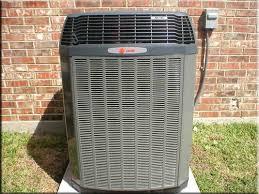It’s Heating Up Outside. Is Your Air Conditioner Going to Survive the Summer?
If your air conditioning (AC) equipment requires frequent repairs, is more than 10 years old, or you’ve noticed that your electric bills have gone up in recent years during the summer, it is time to consider replacing your AC equipment. Being proactive means you won’t have to wait days for an HVAC contractor to replace your unit when it breaks down completely during a 90+ degree heat wave. If you’re ready to replace your air conditioner, you should also consider whether or not your house is properly sealed and has the recommended levels of insulation. Adding insulation before replacing your AC unit will not only help the new equipment run more efficiently, it may actually reduce the size of the AC unit you need, which of course reduces the cost. Insulation and air sealing, whether during the coldest months of winter or the hottest days of summer, are considered to be the best return on investment you can make in your home’s energy efficiency.
Typically when we think of air leaks, we think of drafty doors or windows. However, there are many other ways the air you are paying to “condition,” or cool and heat, could be escaping into the great outdoors. Consider all of the utility penetrations into your home, such as plumbing, electrical, phone, cable, vent stacks, etc. Recessed light fixtures are also big culprits when it comes to allowing conditioned air to escape into the attic—making your air conditioner work that much harder to reach your desired temperature setting. These holes can be filled with caulk or canned foam, and if they’re accessible, this is easily a DIY job. However, if there is insulation covering the floor of your attic, you might consider having an insulation contractor handle this for you. If you’re going to be adding new insulation, and your old insulation has signs of pest infestation or moisture damage, or appears dark—a sign air is moving through it, and it is no longer working–removing it altogether is often the best plan. After sealing all the leaks, the Building Performance Institute and the Department of Energy recommend that attics be insulated to an R-Value (or resistance to conductive heat transfer) of 49 for our climate.
If you’re adding insulation, you should also take into consideration the location of your duct work. If your duct work is running through an uninsulated part of your home, such as in the crawl space or on top of the insulation in your attic, and it is not wrapped in insulation, consider how hot that duct work gets when your attic heats up in the middle of summer (or conversely, how cold it gets in the attic or crawl space during the winter). By the time it reaches the rooms below, your air conditioner has had to work extra hard and cost you more in electricity than if it were insulated or located in a conditioned place in your home. Conditioned in this case means part of the “thermal envelope” or insulated part of your home. Attic insulation is the most important insulation in your home, and where you should begin if you’re upgrading. There are different ways and materials to effectively insulate your attic to R-49, depending on whether you use your attic for storage, whether your air handler and duct work are located there, and a number of other factors.
How do you know if you need more insulation? The easiest way to determine this is by looking across your attic floor. If the existing insulation is level with or below the floor joists, you need more insulation.
An easy way to check whether or not your walls are insulated is to look under your kitchen sink with a flash light. If you don’t see any insulation behind the holes where the plumbing comes in, then it is very likely that your walls are uninsulated. The recommended R-value is 15.
In your basement, if you have a storage or utility room that does not have a finished ceiling, you should be able to see whether the band just above the sill plate (where the foundation meets the ceiling of your basement) around the exterior walls of your home has been insulated. Very often, especially in houses that are more than 40 years old, this essential part of the building envelope was not insulated when the home was built.
Once you’ve addressed air sealing and adequately insulated your home, you’ve made a smart investment that will start saving energy immediately. And, your heating and air conditioning contractor can properly size your new AC unit based on how tight and well insulated your home is. You can rest assured that the significant investment you will put into your new system will money well spent to keep your home cool, comfortable, and healthier. You can also be confident that you aren’t needlessly wasting money by making that new unit work harder than it was designed to, which might lead to a shorter life span or costly repairs.
For a professional evaluation of your insulation needs, or to discuss the different products that might be options for your home, please contact us. We’re happy to provide a free assessment to make sure your home is performing to the best of its ability.


